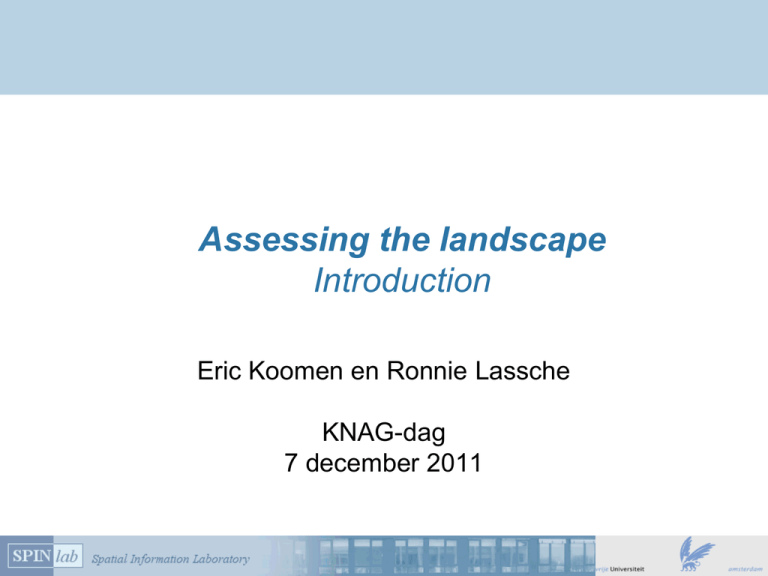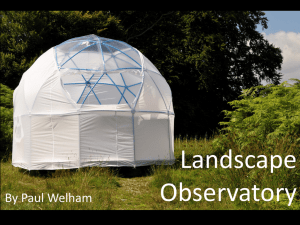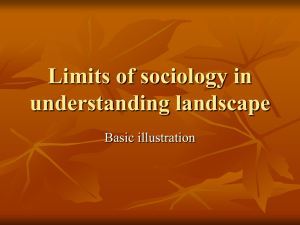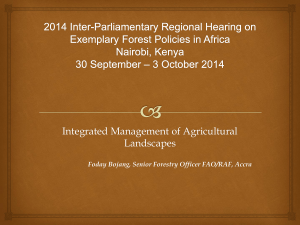
Assessing the landscape
Introduction
Eric Koomen en Ronnie Lassche
KNAG-dag
7 december 2011
Landscape?
van der Heyden, 1660
Definition
land·scape n.
1. An expanse of scenery that can be seen in a single view: a desert landscape.
2. A picture depicting an expanse of scenery.
3. The branch of art dealing with the representation of natural scenery.
4. The aspect of the land characteristic of a particular region: a bleak New England winter
landscape.
5. Grounds that have been landscaped: liked the house especially for its landscape.
[Dutch landschap, from Middle Dutch landscap, region : land, land; see lendh- in Indo-European roots
+ -scap, state, condition (collective suff.).]
Word History: Landscape, first recorded in 1598, was borrowed as a painters' term from Dutch during
the 16th century, when Dutch artists were pioneering the landscape genre. The Dutch word
landschap had earlier meant simply "region, tract of land" but had acquired the artistic sense,
which it brought over into English, of "a picture depicting scenery on land." Interestingly, 34 years
pass after the first recorded use of landscape in English before the word is used of a view or vista
of natural scenery. This delay suggests that people were first introduced to landscapes in
paintings and then saw landscapes in real life.
The American Heritage® Dictionary of the English Language, Fourth Edition copyright ©2000 by Houghton Mifflin Company. Updated in 2009. Published by Houghton Mifflin
Company. All rights reserved.
Definition
• “Landschaft ist das Totalcharakter einer
Erdgegend“
(Alexander von Humboldt, 1807)
• Landscape is our physical surrounding
that is the result of the combination of
physical conditions, biological processes
and human intervention
(own attempt)
Not (only) land cover
Not (only) land use
Description of landscape components
• Descriptive or “measurable” characteristics
–
–
–
–
land cover (and land use)
parcellation
topography (height)
degree of openness
• Interpretative characteristics (describe origin)
–
–
–
–
–
geology
geomorphology
occupation (settlement) history
archaeological remains
historic elements
What is landscape then?
Example: Dutch heathland
Heathland part of historic landscape
Example: Scottish Highlands
Loch Lomond and theTrossachs National Park
Example: Hungarian puszta
National Park Hortobágy - The Puszta
Assessing the landscape
as·sess ( -s s )
1. To estimate the value of (property) for taxation.
2. To set or determine the amount of (a payment, such as a tax or fine).
3. To charge (a person or property) with a special payment, such as a tax or fine.
4. Sports To charge a player, coach, or team with (a foul or penalty).
5. To determine the value, significance, or extent of; appraise. See Synonyms at
estimate.
The American Heritage® Dictionary of the English Language, Fourth Edition copyright ©2000 by Houghton Mifflin Company. Updated in 2009.
Published by Houghton Mifflin Company. All rights reserved.
In our case:
• estimate the value of the landscape
• how can we assess the value of landscape
to give it a proper attention in planning?
Course layout
1. Introduction
–
–
–
–
2.
3.
4.
5.
concepts and definitions
landscape classifications
changing values over time
changes in landscapes (practical)
Landscape components & analyse change
Evaluating landscapes & valuation methods
Economic valuation of landscapes
Landscape and planning
Assessing (valuing) landscapes
Valuation:
• is personal
• depends on perspective
• is not stable over time (example follows)
• can partly be monetarised
• is essential input to planning
Changing values over time
Landscape change: driving forces
• “the forces that cause landscape changes”
• that influence the trajectories of landscape
development (Bürgi et al., 2007)
Examples of landscape change
• Natural forces: e.g. flooding, salinisation
• Cultural forces: e.g. changing preferences
• Economic forces: agricultural intensification,
urbanisation
• Technological forces: e.g. mechanisation
• Political forces: e.g. agricultural policy,
zoning
Landscape changes are not constant
Specific Dutch landscape changes
Four major processes of Dutch landscape
change since 1850:
• 1. cultivation of wilderness areas
• 2. agricultural rationalisation
• 3. urbanisation
• 4. reforestation
You will explore these in the practical.
More processes may be active in your area
Introduction to the practical
• Discern the most important landscape
changes for two contrasting regions
• Focus on the four major processes of
landscape change since 1850
• Look at four time steps: 1850, 1900, 1950
• Requires ArcGIS and connection to the
internet
• Use draw tool in ArcGIS









